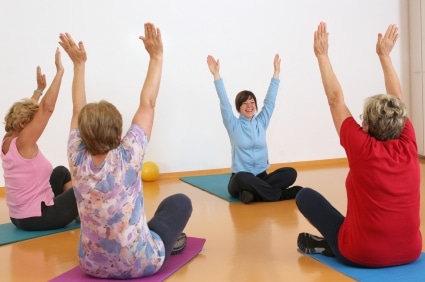
Exercise: always great for the body, right? Right, except for when it’s too much for the body. Athletes at any age are susceptible to strains and overexertion that can lead to injuries that range from inconvenient to permanently painful. For people over fifty, the risk of injury is increased. That’s no excuse to skip exercise in favor of a day on the couch catching up on your favorite show. Exercise offers far too many advantages to your health and life and, once you’ve found the right form, to having a great time as well. The best way to guard against injury is to choose a low-impact form of exercise.
Generally, low-impact exercise is defined as any type where one foot stays on the ground at all times (although that’s not always the case, as no feet are on the ground when riding a bicycle or taking a kayak out). The point is, that low-impact exercise does not put stress on joints and bones. Something to keep in mind, though, is that the distinction between low-impact and high-impact primarily refers to different kinds of cardiovascular exercise. Running is high-impact while walking is low-impact. And while exercises such as yoga can often be low-impact, and is many times a great option, it can also cause injury when not practiced carefully. When undertaking a new form of exercise, it’s a good idea to find a great teacher until you’re familiar with what you’re doing and what your body is capable of.
Tai Chi
A Chinese martial art, this exercise involves slow, meticulous movement, but is a great way to increase flexibility and balance, reducing the risk of falling. Tai Chi also leads to stronger muscles and better posture. It can also lead to many of the same benefits as meditation, including increased concentration and psychological well-being.
Pilates
Having a healthy body that is also strong and resilient is greatly determined by a person’s core strength. And that’s not the figurative core, but literal: the abdominal muscles. Strong abdominals are the absolute best way to guard against a bad back. Pilates was originally created to help dancers build strength without bulk, but since all of the exercises center around the core, it’s one of the best ways to increase whole body strength while also making sure abdominals stay strong, ensuring a well-supported back.
Swimming
If you love the water, you won’t find a form of exercise that offers the body a better cardiovascular workout while minimizing strain on your joints. Swimming has the added benefit of exercising all of the body’s muscles at once. Cardio and strength training at the same time? Maybe it’s time to join a pool!
Elliptical
If your idea of exercise means breaking a sweat while reading a magazine, then the elliptical machine is your best bet. Ellipticals have skyrocketed in popularity over the last 20 years, no doubt because of how they minimize stress to knees and backs, two vulnerable pressure points.
Cycling
Whether you choose to stay in the gym or opt for the open road, you can’t go wrong with cycling. Recently popular, spin classes offer an incredibly effective cardio workout that does not strain joints, while a bicycle ride on country roads is a perfect way to get exercise while getting some fresh air.











